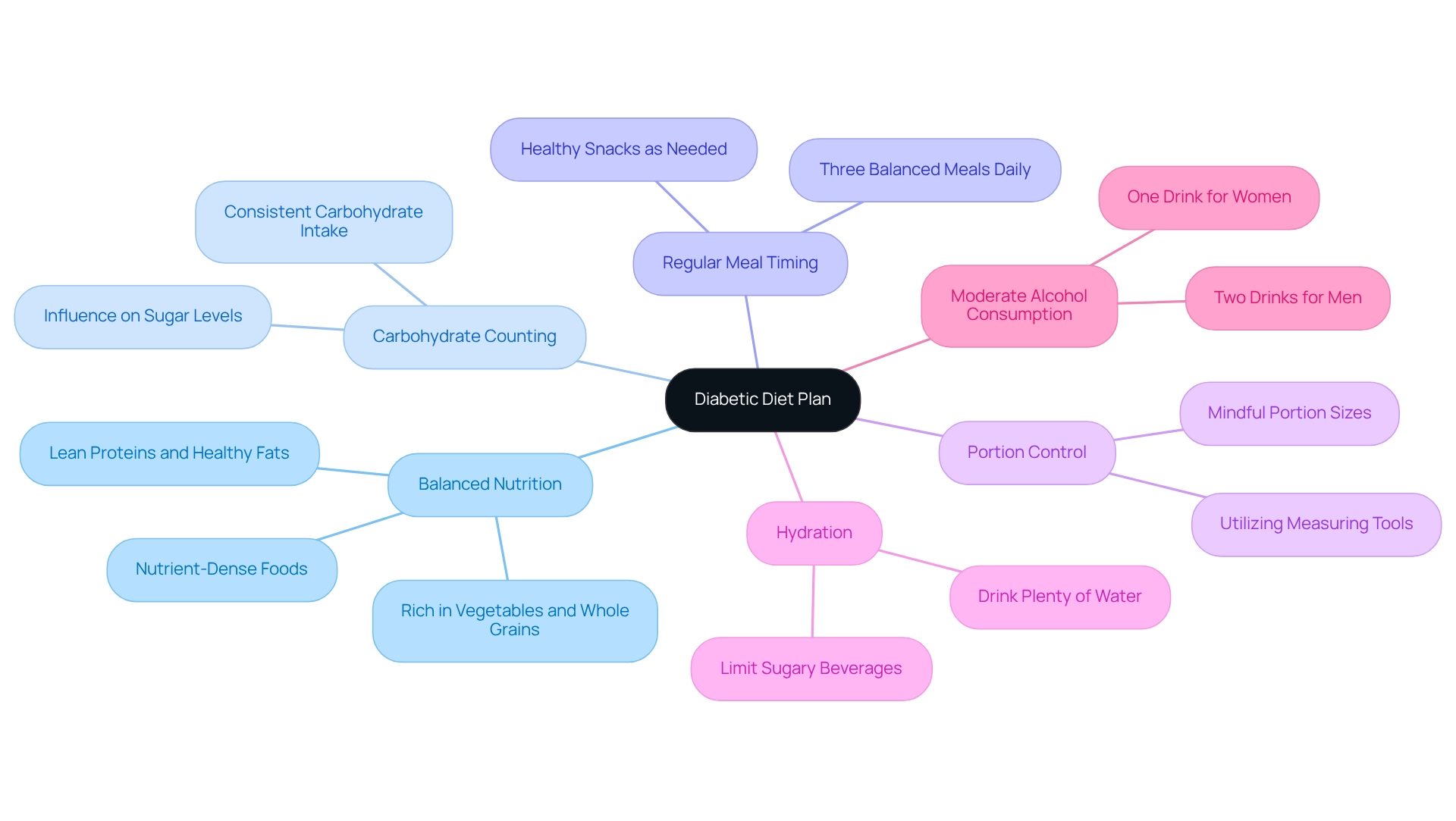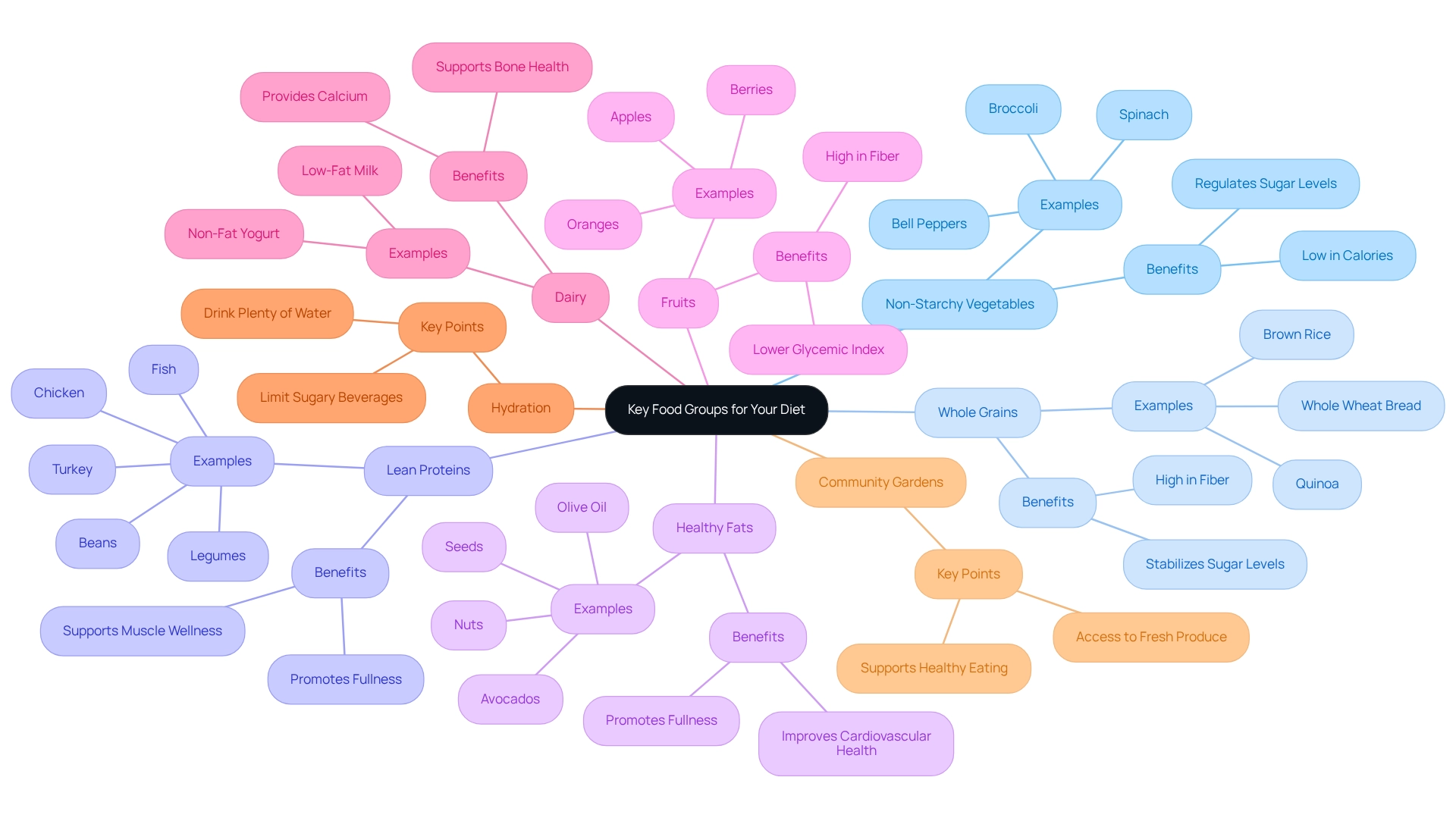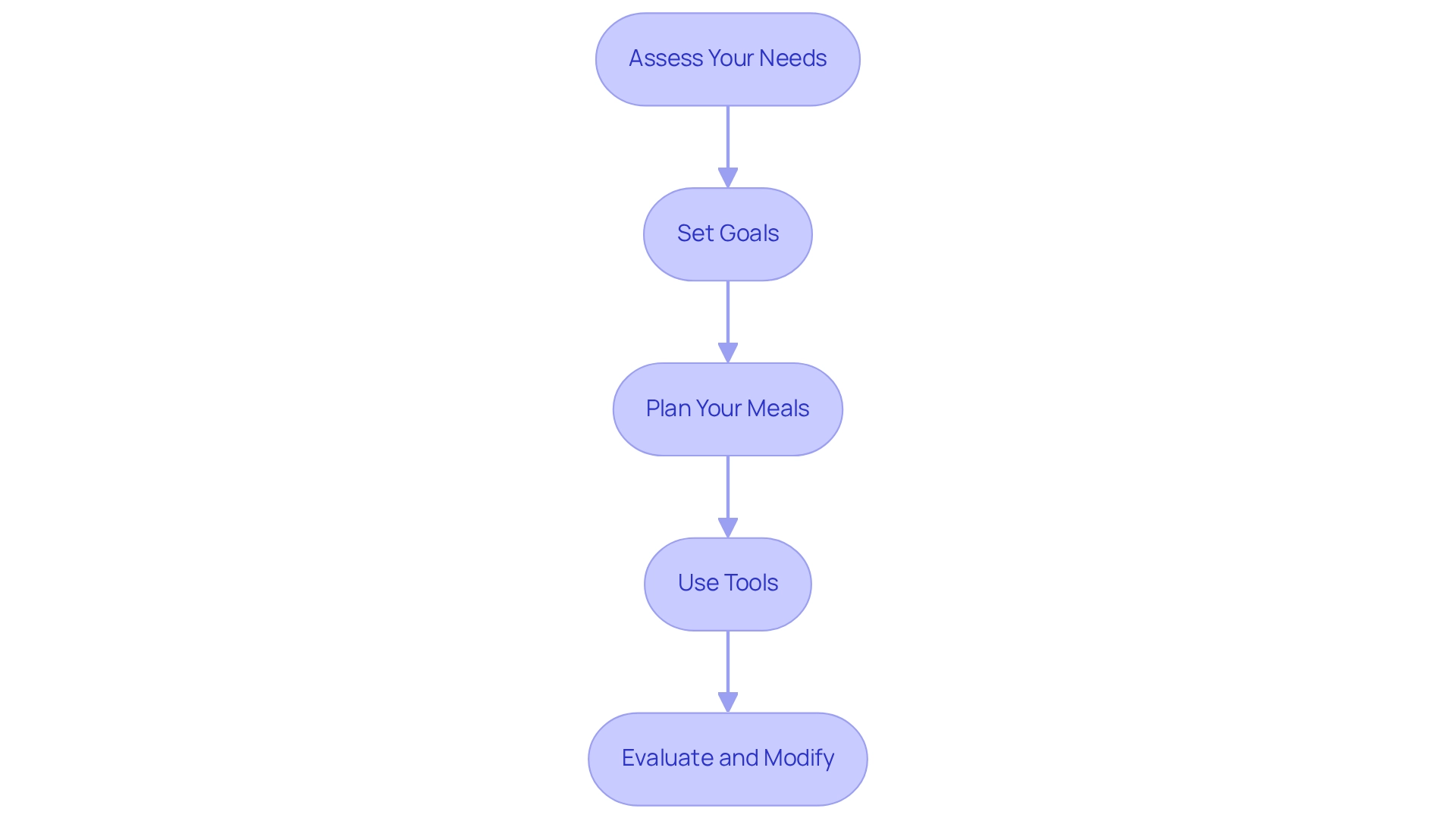Overview
This article is dedicated to helping you create a personalized diabetic diet plan in Spanish, a crucial step in effectively managing diabetes. We understand that navigating this journey can feel overwhelming, but balanced nutrition is key. By focusing on carbohydrate counting and utilizing helpful resources like meal planning apps, you can take control of your dietary choices. Community support plays a vital role, empowering you to make informed decisions that stabilize your blood sugar levels and enhance your overall health.
It's completely normal to feel uncertain about where to begin. Remember, you're not alone in this journey. With the right guidance and tools, you can build a diet plan that fits your needs. We encourage you to explore meal planning apps and connect with others who share similar experiences. Together, we can foster a supportive environment that encourages healthy choices and well-being.
Introduction
In the journey of managing diabetes, understanding the nuances of a well-structured diet can truly transform your experience. A diabetic diet is not just a set of restrictions; it serves as a supportive framework for making informed choices that enhance your overall health while keeping your blood sugar levels in check. From mastering carbohydrate counting to recognizing the importance of balanced nutrition, the essentials of a diabetic diet lay a solid foundation for a healthier lifestyle.
This article explores the key components of an effective diabetic diet plan, offering insights on food groups to prioritize, strategies for meal planning, and valuable resources that can empower you on your path to better health. It's understandable to feel overwhelmed, but by embracing these principles, you can navigate the complexities of diabetes with confidence and clarity. Remember, you're not alone in this journey; we are here to support you every step of the way.
Understand the Basics of a Diabetic Diet Plan
A diabetic eating plan goes beyond simple food limitations; it emphasizes educated decisions that enhance overall health while effectively managing sugar levels. Understanding these essential components can empower you on your journey:
-
Balanced Nutrition: Prioritize a diet rich in vegetables, whole grains, lean proteins, and healthy fats. This nutritional balance is vital for maintaining stable glucose levels and overall well-being. Recent studies show that incorporating nutrient-dense foods—packed with protein, healthy fats, vitamins, minerals, and fiber—can significantly improve health outcomes for individuals with diabetes.
-
Carbohydrate Counting: Mastering carbohydrate counting is crucial, as carbohydrates significantly influence sugar levels. Aim for consistent carbohydrate intake at each meal to help regulate your levels effectively.
-
Regular Meal Timing: Consistent meal timing is essential for glucose regulation. Strive for three balanced meals each day, along with healthy snacks as needed to prevent fluctuations.
-
Portion Control: Being mindful of portion sizes is important to avoid overeating, which can lead to spikes in sugar levels. Utilizing measuring tools can help you maintain appropriate portions.
-
Hydration: Stay well-hydrated by drinking plenty of water and limiting sugary beverages. Adequate hydration supports overall well-being without adversely affecting blood sugar levels.
-
Moderate Alcohol Consumption: If you choose to consume alcohol, moderation is key—no more than one standard drink a day for women or two for men. This is vital for sustaining balanced nutrition and general well-being.
By comprehending these fundamental components, you can create a personalized plan using a diabetic diet Spanish PDF that aligns with your health goals and management strategies. As the NIH states, "All eating plans for managing blood sugar have a few things in common, including consuming the appropriate foods in the correct amounts at the right times." By focusing on balanced nutrition, you can take proactive steps toward effective blood sugar management.
For additional resources and support, consider visiting T2DSolutions, your new center for health education and community support. Subscribe to stay updated on the latest content and tools to assist you in your diabetes management journey. Remember, you're not alone in this journey; we are here to support you every step of the way.

Identify Key Food Groups for Your Diet
Creating an effective diabetic diet Spanish PDF is a journey that can significantly improve your health and well-being. By focusing on the following key food groups, you can take meaningful steps toward managing your diabetes.
-
Non-Starchy Vegetables: It’s important to incorporate a variety of vegetables such as spinach, broccoli, and bell peppers into your meals. These vegetables are low in calories and carbohydrates, making them ideal for regulating sugar levels. Aim for about 2 cups of non-starchy vegetables daily to maximize their benefits. As nutritionist Lindsay Boyers wisely advises, "Try to get about 2 cups from non-starchy vegetables."
-
Whole Grains: Choosing whole grains like brown rice, quinoa, and whole wheat bread can be beneficial. These options are high in fiber and vital nutrients that assist in stabilizing sugar levels. Research shows that incorporating whole grains into your meals can significantly enhance blood sugar control.
-
Lean Proteins: Including sources such as chicken, turkey, fish, beans, and legumes is essential. Protein not only helps you feel full but also promotes muscle wellness, which is vital for your overall health.
-
Healthy Fats: Don’t forget to add healthy fats from avocados, nuts, seeds, and olive oil. These fats can improve cardiovascular health and promote a sense of fullness, making them a valuable part of your diet.
-
Fruits: Opt for whole fruits instead of juices to benefit from their fiber content. Berries, apples, and oranges are excellent choices due to their lower glycemic index, which aids in effectively regulating sugar levels.
-
Dairy: Selecting low-fat or non-fat dairy options will provide you with calcium and protein without the excess saturated fat. This choice supports bone health while fitting into a balanced nutrition plan.
-
Hydration: Remember to drink plenty of water throughout the day and limit sugary beverages. Staying hydrated is crucial for your overall well-being and can assist in blood sugar control.
By concentrating on these food categories outlined in the diabetic diet Spanish PDF, you can develop a balanced meal plan that not only aids in managing your diabetes but also enhances your overall health and vitality. It’s also worth considering community gardens, which can provide access to fresh produce for families in need, making healthy eating more accessible for everyone. You're not alone in this journey; we are here to support you every step of the way.

Create Your Personalized Diabetic Diet Plan
Creating your personalized diabetic diet Spanish PDF can feel overwhelming, but by following these essential steps, you can take control of your health journey with confidence:
-
Assess Your Needs: Start by evaluating your daily caloric requirements, activity level, and any specific dietary restrictions or preferences. Understanding these factors is crucial, as nearly 80 percent of deaths among diabetics are linked to complications from poor dietary management, particularly cardiovascular issues. A personalized diet plan can significantly mitigate these risks by ensuring balanced nutrition tailored to your needs. Consider utilizing resources from T2DSolutions to help assess your dietary needs effectively.
-
Set Goals: Establish clear, achievable dietary goals that align with your health needs. For instance, you might aim to reduce carbohydrate intake or increase your vegetable consumption. As diabetes educators emphasize, setting realistic goals is vital for long-term success in managing diabetes. Remember, as Joel Fuhrman wisely states, 'The more greens you consume, the more weight you will lose.' This highlights the importance of including vegetables in your meals. T2DSolutions can provide additional guidance on setting these goals, which may include a diabetic diet Spanish PDF.
-
Plan Your Meals: Structure your meals using this simple template:
- Breakfast: Incorporate a source of protein (e.g., eggs), a whole grain (e.g., oatmeal), and a fruit (e.g., berries).
- Lunch: Focus on lean protein (e.g., grilled chicken), a generous portion of non-starchy vegetables, and a whole grain (e.g., quinoa).
- Dinner: Choose healthy fats (e.g., olive oil), lean protein (e.g., fish), and a variety of vegetables.
- Snacks: Select nutritious options like nuts, yogurt, or sliced vegetables.
Consulting with a dietitian during this planning phase can enhance your meal choices and ensure they align with your dietary goals. T2DSolutions will also offer tools and resources for meal planning, including a diabetic diet Spanish PDF to assist you.
-
Use Tools: Leverage meal planning apps or templates to organize your meals and track your food intake effectively. These tools can simplify the process and help you stay on track with your dietary goals. Keep an eye out for tools that T2DSolutions will provide once the site is fully operational.
-
Evaluate and Modify: Regularly review your nutrition plan and make necessary changes based on your glucose levels and overall health. Collaborating with healthcare providers and dietitians can enhance your dietary compliance, reducing the risk of fluctuating blood sugar levels and serious complications. It's important to remember that non-adherence to nutritional guidelines can lead to negative health effects, so maintaining open dialogue with your healthcare team is crucial. T2DSolutions encourages you to engage with their community for support and shared experiences, and by following these steps, you can create a personalized diabetic diet Spanish PDF that not only aids in the effective management of your condition but is also enjoyable and sustainable, promoting a healthier lifestyle. You're not alone in this journey; consider connecting with the T2DSolutions community for assistance and shared experiences, as managing this condition is a collective effort.

Access Tools and Resources for Effective Planning
To enhance your meal planning and blood sugar management, consider the essential tools and resources available through T2DSolutions.
Meal Planning Apps: Utilizing popular apps like MyFitnessPal and Diabetes:M can be a game-changer. These tools not only help track food intake but also monitor blood sugar levels and facilitate effective meal planning. Many users have reported enhanced dietary habits and improved blood sugar management. For instance, a participant in Year 5 with previously poor blood sugar management demonstrated age-appropriate knowledge of carbohydrate counting. This highlights the crucial role education plays in effectively managing diabetes.
Diabetes Education Websites: It's beneficial to leverage resources from reputable organizations such as the American Diabetes Association and the CDC, along with T2DSolutions. These websites offer comprehensive meal planning guides, nutritious recipes, and essential nutritional information, including a diabetic diet Spanish PDF. Engaging with these educational resources can significantly enhance your understanding and management of diabetes.
Printable Meal Planning Templates: You can access online templates designed to help you organize your weekly meals. These templates enhance your ability to visualize food choices, ensuring a balanced and varied diet that aligns with your health goals.
Community Support Groups: Participating in local or online support groups for blood sugar management, including those organized by T2DSolutions, can be invaluable. These communities offer encouragement, share personal experiences, and provide practical tips from individuals who understand the challenges of managing diabetes. T2DSolutions emphasizes the importance of community support, illustrated by a case study where building relationships and exchanging information led to enhanced well-being for users.
Consult a Dietitian: Collaborating with a registered dietitian can provide personalized dietary guidance tailored to your unique health needs and preferences. This professional support can significantly enhance your meal planning efforts and overall diabetes management.
By utilizing these tools and resources, including those offered by T2DSolutions, you can create a more effective and enjoyable meal planning experience. Remember, you're not alone in this journey, and with the right support, you can achieve improved diabetes management and a healthier lifestyle.

Conclusion
Embracing a well-structured diabetic diet can significantly enhance your journey in managing diabetes and improving overall health. Key components—such as balanced nutrition, carbohydrate counting, regular meal timing, portion control, and adequate hydration—form the backbone of a successful dietary strategy. By prioritizing non-starchy vegetables, whole grains, lean proteins, healthy fats, and low-fat dairy, you can create a diet that effectively stabilizes blood sugar levels and promotes vitality.
Creating a personalized diet plan is an essential step in this journey. By assessing your individual needs, setting achievable goals, planning meals thoughtfully, and utilizing helpful tools and resources, you can tailor your dietary approach to better align with your health objectives. Engaging with supportive communities, such as those facilitated by T2DSolutions, can provide invaluable encouragement and shared experiences that enrich the diabetes management process.
Ultimately, managing diabetes through diet is not just about restrictions; it’s about making informed choices that lead to a healthier and more fulfilling life. With the right knowledge and support, navigating the complexities of a diabetic diet can become a source of empowerment. Remember, you’re not alone in this journey—together, we can take control of our health and well-being.
Frequently Asked Questions
What is the primary focus of a diabetic eating plan?
A diabetic eating plan goes beyond food limitations; it emphasizes educated decisions that enhance overall health while effectively managing sugar levels.
What components are essential for a balanced diabetic diet?
Essential components include balanced nutrition, carbohydrate counting, regular meal timing, portion control, hydration, and moderate alcohol consumption.
Why is balanced nutrition important for individuals with diabetes?
Balanced nutrition, which includes vegetables, whole grains, lean proteins, and healthy fats, is vital for maintaining stable glucose levels and overall well-being.
How does carbohydrate counting help in managing diabetes?
Mastering carbohydrate counting is crucial as carbohydrates significantly influence sugar levels. Consistent carbohydrate intake at each meal helps regulate glucose levels effectively.
What role does meal timing play in blood sugar regulation?
Consistent meal timing is essential for glucose regulation, with a recommendation to have three balanced meals each day along with healthy snacks to prevent fluctuations.
How can portion control impact diabetes management?
Being mindful of portion sizes helps avoid overeating, which can lead to spikes in sugar levels. Utilizing measuring tools can assist in maintaining appropriate portions.
What is the importance of hydration for individuals with diabetes?
Staying well-hydrated by drinking plenty of water and limiting sugary beverages supports overall well-being without adversely affecting blood sugar levels.
What are the guidelines for alcohol consumption for people with diabetes?
If choosing to consume alcohol, moderation is key—no more than one standard drink a day for women or two for men is recommended for balanced nutrition and general well-being.
How can individuals create a personalized diabetic eating plan?
By understanding the fundamental components of a diabetic diet, individuals can create a personalized plan that aligns with their health goals and management strategies.
Where can individuals find additional resources for diabetes management?
Additional resources and support can be found at T2DSolutions, a center for health education and community support.



